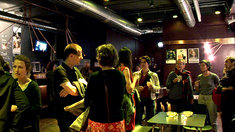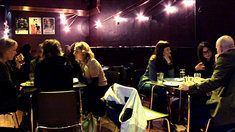This conference[1] considered current theoretical discourses and artistic positions on performance art, the construction of social and cultural memory, sites of memory and archives and processes and practices of reactivating them, while keeping the central focus on fundamental possibilities of transmission and archiving. These were also examined in terms of how they intersect with approaches to memory and media theory. The live performances given during the conference dealt with the issues mentioned above in various ways from an artistic perspective. Some of the artists made direct reference in their presentations or live performances to issues and approaches which had crystallised in the course of the research on the model archive. The trans-disciplinary approach of the conference thus facilitated not only the visualisation of different practice-oriented methods of transcription but also their specialist discussion. In the process, it became clear that there are many artistic methods of transmission which can contribute to theorisation and historicisation. In this respect, we were also concerned with creating a space where knowledge can be exchanged and reflected on and where participants can learn from one another.
Main points and aims of the inquiry
In the course of the research project, pursuing the following main points proved most productive:
A) Which specific qualities and characteristics of transmission and transcription are demonstrated by artefacts of performance art?
Findings from the interviews were qualitatively categorised and applied to the various artefact types. We then analysed, compared and reviewed the artefacts (photographs, video recordings, texts, sketches, eyewitness reports, relics), which were produced during the course of the model archive and the conference (see part 3). In this respect, our own involvement, and the possible lack of objective distance to the examined objects which this resulted in, called for careful, critical reflection. The final results went into our recommendations (see Part 4).
B) How and by what means are users of artefacts and materials inspired to create transcriptions?
During our research in a number of archives, we aimed to examine selection processes and their transparency and to check the accessibility of documents. Our qualitative evaluation revealed that greater efforts must be made here, since performance art can only be inscribed in history by accessible artefacts. For this reason, one of our goals in the practice-led phase was to show how an ‘archive’ can be operated performatively, i.e. we researched methods of reactivating performance art with artefact users. We were able to show that artistic research can be equally instrumental in transcribing and theorising performance art as theoretical research. Our supposition was confirmed that performance art is particularly well suited to reflecting on concepts and methods of transcription (see Parts 2, 3 and 4). In the assessment phase, in cooperation with the ZHdK’s media archive of the arts, we took the first steps towards making the artefacts of our case studies visible in a standardised, researchable database.[2] Considering questions of conservation and the technical aspects of preserving artefacts would have gone beyond the scope of our project but we would like to point to some other projects which have experience of dealing with these issues (see the links in Part 4).
C) Which intentional modifications and added value does the ‘original’ performance idea gain by different forms of recording or other performative methods of transcription?
Through our research we were able to show, among other things, that re-enactments, as a form of transmission, are – intentionally or unintentionally – complicit in the current hype surrounding the concept of the ‘original’ and presence. They are to be understood as one of many methods of transmission, alongside re-performances and other appropriation strategies. While ‘iconic’ performances, especially, in which an artist’s celebrity plays a central role (e.g. Joseph Beuys, Marina Abramovic) evade critical, productive transcription, works based on written directions or a score seem to positively invite it. However, one should always question a performance’s historical contextualisation, the motivations behind reactivation, and whether and for what reason it consciously or unconsciously transcribes or re-inscribes the ‘original’ concept (see Parts 2, 3, and 4).
[1] Kaserne Basel, 6-8.10.2011; for the conference participants and programme, see ‘Related documents’ (flyer and conference folder).
[2] On the performance vocabulary for the MAdeK database, see ‘Related documents’.































